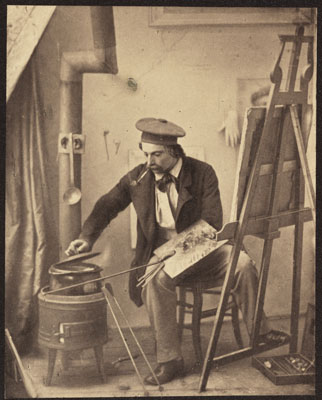
Übermalte Fotografie, 20,9 x 16,6 cm
Bibliothèque nationale de France Paris
La Bohème
Marie-Alexandre Alophe » Hermann Biow » Hugo Erfurth » Franz Hanfstaengl » Nadar (Gaspard-Félix Tournachon) » August Sander » & others
Exhibition: 25 Sep 2010 – 9 Jan 2011

Museum Ludwig
Heinrich-Böll-Platz
50667 Köln
+49 (0)221-22126165
info@museum-ludwig.de
www.museum-ludwig.de
Tue-Sun 10-18
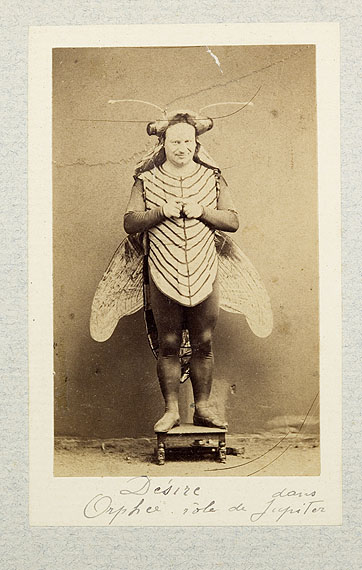
Museum Ludwig Köln
“La Bohème”. The Staging of Artists in photography of the 19th and 20th century In his 1851 novel Scènes de la Vie de Bohème, the French author Henri Murger created the image of the artist as an outsider who, in the midst of the middle class era, lived in romantic poverty. Bohemian life, viewed through rose-tinted glasses and elevated to undying popularity by Puccini’s opera, constituted in Murger’s view a transitional stage: “Bohemia is the first stage in artistic life; it is the preface to the Academy, the hospital, or the Morgue.” The term became synonymous with the 19th century artist who was dependent on an anonymous market and, while free of constraints, had to sell the fruits of his labours without the patronage of the courts. In the middle of this period in which the legend of the Bohemian swelled to bolster the artists’ feelings of self-confidence, came the invention of photography. Just how far this colourful approach to life was mirrored in photographic stagings of artists will be examined in this exhibition at Museum Ludwig. It traces out the idea of the Bohemian milieu in photographic portraits, scenes and stagings. The span of the work covered here extends from the earliest Daguerreotypes to the striking portraits by Nadar and the opulent artists’ banquets of the 1920s. Thus for instance Louis Alphonse de Brébisson staged around 1842 a group of friends painting and playing instruments as the quintessence of a romantic artists’ association in Bohemia. Felix Tournachon, known as Nadar, was not only a leading member of the Parisian Bohemians, he also created legendary portraits of his friends and contemporaries. No less ingenious was the collaboration between David Octavius Hill and Robert Adamson, whose group photographs such as Edinburgh Ale aimed at positioning themselves close to the artistic Bohemia. Historical pageants and so-called tableaux vivants tell of the lengths people went to dress up, not least for the artists’ and academy balls in the 19th century. Also on show are numerous poetic stagings done after historical models by David Wilkie Wynfield, a Pre-Raphaelite photographer, and Julia Margaret Cameron. Paris remained however the metropolis of art and artists, and so the self-stagings from around 1900 by the artists of Montmartre and Montparnasse, such as Modigliani and Picasso, testify to their will to style. Likewise the figure of the dandy rose up amid this milieu in 19th century France. Stunning examples of this include the self-representations of the Pictorialists, such as Alfred Stieglitz and Frank Eugene Smith. The outlandish costumes in which the author Pierre Loti dressed up and the studio scenarios created for instance by Alphonse Mucha were also directly imbued with typical French flair. A special highlight will be the photographs of Ernst Ludwig Kirchner, in which self-staging was wed with deep psychological introspection. Opulent and fanciful were the artists’ parties of the 1920s; on show will be examples from the Malkasten Düsseldorf, from Cologne, Hamburg, and from the Bauhaus in Weimar and Dessau, photographed by leading photographers such as August Sander and T. Lux Feininger. „La Bohème“. Die Inszenierung des Künstlers in Fotografien des 19. und 20. Jahrhunderts Der französische Autor Henri Murger prägte 1851 in seinen "Scènes de la Vie de Bohème" das Bild vom Künstler als Außenseiter, der im bürgerlichen Zeitalter in romantischer Armut lebt. Die Boheme, heiter verklärt und durch Puccinis Oper vollends popularisiert, war für Murger ein Durchgangsstadium: „Die Bohème ist die Vorstufe des Künstlerlebens, sie ist die Vorrede zur Akademie, zum Hospital oder zum Leichenschauhaus.“ Der Begriff wurde zum Synonym für den Künstler des 19. Jahrhunderts, der einem anonymen Markt ausgesetzt war und frei von Zwängen, aber auch ohne den Schutz der Höfe seine Leistungen verkaufen musste. Mitten in die Zeit der Entstehung der Boheme-Legende zur Untermauerung künstlerischen Selbstbewusstseins fiel die Erfindung der Fotografie. Inwieweit sich die schillernde Lebenseinstellung auch in den fotografischen Inszenierungen von Künstlern spiegelt, untersucht diese Ausstellung im Museum Ludwig. Sie verfolgt die Idee der Boheme in fotografierten Darstellungen, Szenen und Inszenierungen. Der Bogen spannt sich von frühesten Daguerreotypien über die markanten Portraits von Nadar bis zu den opulenten Künstlerfesten der 1920er Jahre. So inszenierte etwa Louis Alphonse de Brébisson um1842 eine Gruppe musizierender und malender Freunde als Inbegriff einer romantischen Künstlergemeinschaft der Boheme. Felix Tournachon, genannt Nadar, war nicht nur führendes Mitglied der Pariser Boheme, sondern schuf auch legendäre Portraits seiner Freunde und Zeitgenossen. Genial war ebenso die Zusammenarbeit von David Octavius Hill und Robert Adamson, deren Gruppenaufnahmen wie „Edinburgh Ale“ das Ziel hatten, sich selbst in die Nähe der künstlerischen Boheme zu rücken. Historienspiele und sogenannte „Lebende Bilder“ erzählen vom Verkleidungsaufwand unter anderem auf Künstler- und Akademiefesten des 19. Jahrhunderts. Von David Wilkie Wynfield, einem präraffaelitischen Fotografen, wie Julia Margaret Cameron, werden zahlreiche poetische Inszenierungen nach historischen Vorlagen gezeigt. Paris blieb jedoch die Metropole der Kunst und Künstler, und so sind es um 1900 die Selbstinszenierungen der Künstler aus Montmartre und Montparnasse, etwa Modigliani und Picasso, die vom Stilwillen der Dargestellten zeugen. Auch die Sozialfigur des Dandys ist im französischen Milieu des 19. Jahrhunderts entstanden. Schillernde Beispiele sind die Selbstdarstellungen der Piktorialisten wie Alfred Stieglitz oder Frank Eugene Smith. Die skurrilen Verkleidungen des Schriftstellers Pierre Loti und die Atelierszenarien eines Alphonse Mucha wurden vom französischen Flair ebenfalls maßgeblich inspiriert. Einen besonderen Akzent bilden die Fotografien von Ernst Ludwig Kirchner, in denen die Selbststilisierung mit psychologisierender Innenschau verknüpft wird. Opulent und phantasievoll sind die Künstlerfeste der 1920er Jahre; gezeigt werden Beispiele aus dem Malkasten Düsseldorf, aus Köln, Hamburg, und vom Bauhaus in Weimar und Dessau, fotografiert von bedeutenden Fotografen wie August Sander oder T. Lux Feininger.
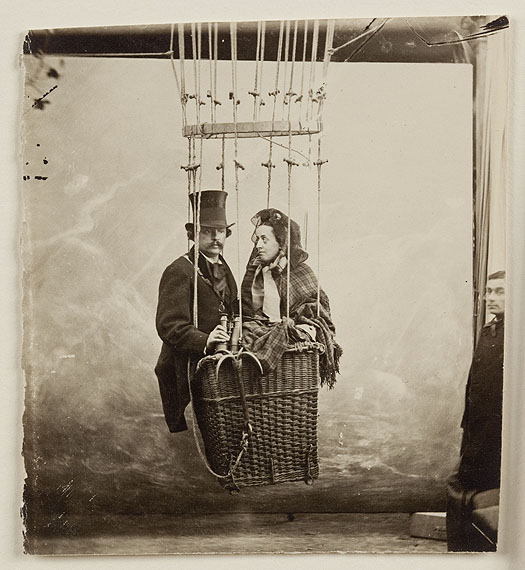
Albuminpapier, 9x8 cm
Sammlung Thomas Walther
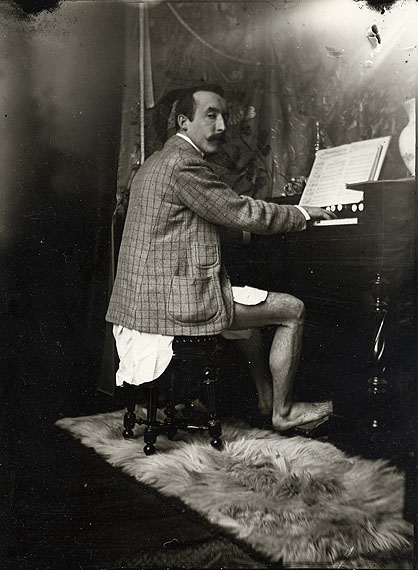
Silbergelatine, 24 x 18 cm
Mucha Foundation, Prag
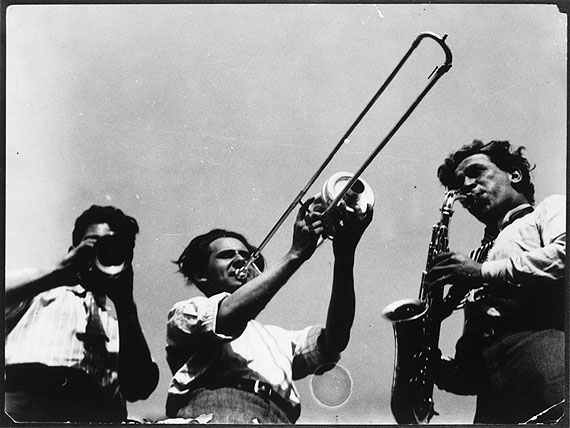
Silbergelatine, 9x12 cm
Copyright: T. Lux Feininger
Bauhaus-Archiv Berlin